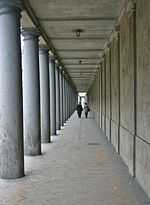Stormgade

Stormgade (lit. "Storm Street") is a street in central Copenhagen, Denmark. It runs from Frederiksholm Canal to H. C. Andersens Boulevard where it turns into Tietgensgade before continuing along the rear side of Tivoli Gardens and Copenhagen Central Station. In the opposite direction, Storm Bridge connects it to Slotsholmen where traffic may continue across Holmen's Bridge to Holmens Kanal, part of Ring 2, or across Knippel's Bridge to Christianshavn and Amager. The name of the street refers to the Swedish Storm of Copenhagen in 1659.
Histoy
.jpg)
The area south of Slotsholmen was originally part of the shallow-watered area known as Kalveboderne. The coast line ran approximately where Stormgade runs today. On the night between 10 and 11 February 1658, Swedish troops made an assault on Slotsholmen across the ice. After the attack, it was decided to improve the defense of Slotsholmen by extending Copenhagen's Western Rampart into the water. The area between the rampart and the new Frederiksholm Canal was reclaimed and developed into a small new neighbourhood with three short streets: Slotsholmen, Ny Vestergade and Ny Kongensgade.[1]
.jpg)
When the Western Rampart was removed in the late 1870s, Stomgade was extended with one block to Vestre Boulevard (now H. C. Andersens Boulevard).
In entire southeast side of the street was demolished in 1931 to make way for an expansion of the National Museum. One of the buildings had from 1783 until 1923.[2]
Notable buildings and residents

National Museum's façade on Stomgade date from 1929-1938. Its most distinctive feature is the colonnade with 38 columns in Bornholmian granite which runs along the full length of the building.[3]
No. 6 is from 1851 and was listed in 1918. No. 8 was originally two separate, dating buildings from some time before 1734, which were merged into one in 1748.[4]
The Holstein Mansion was originally built in 1687 but owes its current appearance mainly to an expansion carried out by Jacob Fortling in 1756. Ut was home to the Natural History Museum between 1827 and 1871.
Det Harboeske Enkefruekloster (No. 14) was rebuilt by Elias David Häusser in 1741 but owes its current appearance to expansions and alterations carried out by Lauritz de Thurah between 1754 and 1760.[5]
The corner building at No. 16 was built for royal pastry-maker Jens Raae in 1791. The dormer on Stormgade was added in 1811 and the building has undergone several alterations since ten. It was listed in 1945.
The corner building at No. 20, on the other side of Vester Voldgade, was originally built for Overformynderiet, a financial institution that later moved to a new building in Holmens Kanal. The building was designed by Hans Jørgen Holm and is from 1884.[6] In 2014, it was decided to convert it, together with the neighbouring building at No. 22, into a new home for the Museum of Copenhagen.[7]
References
- ↑ "Stormgade" (in Danish). indenforvoldene.dk. Retrieved 2014-09-18.
- ↑ "De fromme brødre i Stormgade" (in Danish). Berlingske. Retrieved 2014-09-18.
- ↑ "Stormgade 1-5/Vester Voldgade 101/Ny Vestergade 10 / Frederiksholms Kanal 12" (in Danish). indenforvoldene.dk. Retrieved 2014-09-18.
- ↑ "Stormgade 8" (in Danish). indenforvoldene.dk. Retrieved 2014-09-18.
- ↑ "Stormgade 14a-f" (in Danish). indenforvoldene.dk. Retrieved 2014-09-18.
- ↑ "Sag: Overformynderiet (tidl.)" (in Danish). Kulturstyrelsen. Retrieved 2014-01-03.
- ↑ "Københvns Museum flytter til Stormgade" (in Danish). Københavns Museum. Retrieved 2014-09-18.
- Stormgade on indenforvolden.dk
External links
| Wikimedia Commons has media related to Stormgade. |